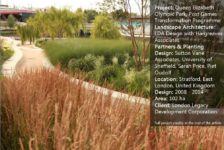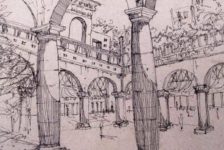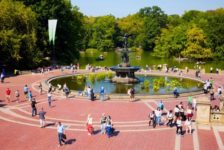Jill Bellenger, ASLA, CPH
LEED, or Leadership in Energy and Environmental Design, can still be a bit of an enigma. Depending on who you’re talking to, landscape architects are either considered an integral part of a project’s LEED certification process, or a superfluous afterthought. And ironically, these views seem to come from some of the landscape architects themselves, as they ponder their implications in such a building-based program.
Just browsing through the LEED for New Construction (LEED-NC) credit template, it certainly does appear to be heavily weighted towards a building’s interior systems. But a closer look reveals the real impact and may help increase understanding of this ‘green by nature’ profession.
Under the new LEED-NC v3, landscape architects are the primary or secondary responsible party for the majority of the credits in the Sustainable Sites and Water Efficiency categories:
– Site Development (SSc5.1 & 5.2) for 2pts
– Stormwater Design Quantity and Quality (SSc6.1 & 6.2) for 2pts
– Heat Island Effect Roof and Non-Roof (SSc7.1 & 7.2) for 2pts
– Light pollution reduction (SSc8) for 1pt
– Innovative wastewater technologies (WEc2) for 2pts
– Water Efficient Landscaping (WEc1.1 & 1.2) for 4pts
As well as a major contributing party towards these critical areas when relating to site issues:
– Sustainable Sites prerequisite
– Site selection (SSc1) for 1pt
– Development density and community connectivity (SSc2) for 5pts
– Brownfield redevelopment (SSc3) for 1pt
– Alternative Transportation – Public Transport. Access (SSc4.1) for 6pts
– Alternative Transportation – Bicycle Storage (SSc4.2) for 1pt
– Alternative Transportation – Parking Capacity (SSc4.4) for 2pts
– Construction Waste Management (MRc2) for 2pts
– Materials Reuse (MRc3) for 2pts
– Recycled Content (MRc4) for 2pts
– Regional Materials (MRc5) for 2pts
– Rapidly Renewable Materials (MRc6) for 1pt
– Certified Wood (MRc7)for 1pt
Not including the innovation and design process category or the varying regional credits for each state (a total of 10 additional points), a landscape architect has a hand in attaining up to 39 of these 90 LEED-NC points, or over 40%.
Bringing it all Together
To further emphasize the importance of site design, the American Society of Landscape Architects teamed up with the Texas-based Lady Bird Johnson Wildflower Center in 2005 to introduce a new comprehensive program based on sustainable land development and management principles. Called the Sustainable Sites Initiative, or SSI, the program is meant to be implemented whether there is a building on site or not, such is the case for parks and ecological restorations.
April Phillips, founder and principal of April Phillips Design Works based in Sausalito, CA, was instrumental in forming the SSI. She states that, “the SSI will be one of the first rating systems to consider human health and well being outside of a building. Its landscape aim is to design more regenerative sites and systems that ultimately could be net zero or better.
“[The Sustainable Sites Initiative] represents thousands of hours with input from 37 technical advisors in hydrology, vegetation, soils, materials and human health and well being. These credits were tailored to apply to any landscape…as a stand-alone system, but is also being designed to fit into the future LEED bookshelf system.”
Another big development coming from the US Green Building Council is the first LEED rating system to focus on the certification of entire neighborhoods, rather than one building at a time. LEED for Neighborhood Development, or LEED-ND, is currently monitoring nearly 240 neighborhoods through the pilot program, 61 of which have become certified as of March 1, 2010. Because of the scale of these neighborhood projects, certification is in a series of three stages, and projects may obtain a preliminary certification before end of construction.
Much like the LEED for Commercial Interiors, or LEED-CI, rating system is heavily reliant on involvement from interior designers, the LEED-ND system brings landscape designers and planners into the forefront. With credit categories such as Smart Location & Linkage, and Green Construction & Technology, this system aims to improve the way we design our communities, making them more sustainable for the future.
For more information: www.sustainablesites.org, www.asla.org, and www.usgbc.org/leed/nd/
This article originally appeared in 3 Design Consulting’s e-newsletter, Sustainability Monthly Report. It has been updated to reflect new industry data. To subscribe to the newsletter, email info@3designconsulting.com with ‘subscribe’ in the subject line.
Published in Blog










Rafael Montilla
Thanks for the information about landscape architects
This link is not working http://www.sustainablesites.org/
nca
Good post Jill.
I am just wrapping up a LEED Site Plan for a new school. I thought it was kind of funny- We just did the site plan, then plugged in the (LEED) sustainable sites requirements at the end for the most part and seem to be well within rnage for earrning the credits.
I think there could be more done to push site design in a more sustainable direction. I think we’re getting there and should do what we can to keep our collective selves involved in the discussion, whether through SSI or otherwise.
Jon Quackenbush
Stormwater design only gets 2pts? That seems silly too me given that it really can have the most significant ecological impact…